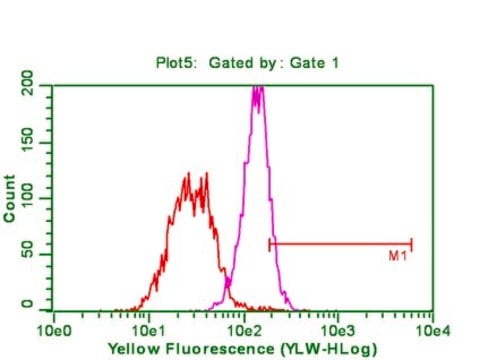MABE647
Anti-acetyl-Histone H3 (Lys27) Antibody, clone RM172
clone RM172, from rabbit
Sinônimo(s):
Histone H3.3, Histone H3
About This Item
Produtos recomendados
fonte biológica
rabbit
Nível de qualidade
forma do anticorpo
purified antibody
tipo de produto de anticorpo
primary antibodies
clone
RM172, monoclonal
reatividade de espécies
human
técnica(s)
multiplexing: suitable
western blot: suitable
Isotipo
IgG
nº de adesão UniProt
Condições de expedição
wet ice
modificação pós-traducional do alvo
acetylation (Lys27)
Informações sobre genes
human ... H3F3B(3021)
Descrição geral
Especificidade
Imunogênio
Aplicação
Epigenetics & Nuclear Function
Chromatin Biology
Qualidade
Western Blotting Analysis (WB): 1 μg/mL of this antibody detected acetyl-Histone H3 (Lys27) in sodium butyrate treated HeLa acid extract.
Descrição-alvo
forma física
Armazenamento e estabilidade
Note: Variability in freezer temperatures below -20°C may cause glycerol containing solutions to become frozen during storage.
Outras notas
Exoneração de responsabilidade
Not finding the right product?
Try our Ferramenta de seleção de produtos.
Código de classe de armazenamento
12 - Non Combustible Liquids
Classe de risco de água (WGK)
WGK 2
Ponto de fulgor (°F)
does not flash
Ponto de fulgor (°C)
does not flash
Certificados de análise (COA)
Busque Certificados de análise (COA) digitando o Número do Lote do produto. Os números de lote e remessa podem ser encontrados no rótulo de um produto após a palavra “Lot” ou “Batch”.
Já possui este produto?
Encontre a documentação dos produtos que você adquiriu recentemente na biblioteca de documentos.
Nossa equipe de cientistas tem experiência em todas as áreas de pesquisa, incluindo Life Sciences, ciência de materiais, síntese química, cromatografia, química analítica e muitas outras.
Entre em contato com a assistência técnica








